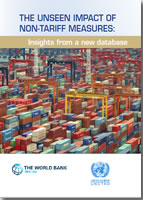
prepared within the UNCTAD-World Bank project "Top 25 Markets",
led by Chad Bown and Ralf Peters.]
Non-tariff measures inhabit the grey zone where trade policy meets national regulation. They are generally defined as policy measures other than ordinary customs tariffs that can potentially have an economic effect on international trade. While tariffs are relatively transparent and have been regularly compiled into public databases, non-tariff measures are not always easy to identify and have only been sporadically collected for relatively few countries. With new data, this report sheds new light on the usage and impact of NTMs.
Most traded goods are affected by non-tariff measures. The majority of NTMs are regulatory measures while traditional trade measures such as quotas and non-automatic licensing are now less common. Since most regulations apply equally to domestic products, NTMs affect most of the products that we encounter in our daily lives: packaging requirements and limits on the use of pesticides ensure safe food; restrictions on toxins in toys protect our children; mandatory voltage standards for household plugs enable regional mobility; and emission standards for cars limit climate change.
While tariffs are clear in their intent, the role of NTMs is less straightforward. On the one hand, many regulatory NTMs are indispensable for sustainable development. They aim to protect human, animal or plant health as well as the environment. These objectives are at the core of social and environmental sustainability policies and the measures are legitimate tools in countries' efforts to achieve the Sustainable Development Goals. On the other hand, NTMs can also raise costs and create hurdles for trade and economic development. Private sector surveys indicate that technical regulations, as well as related processes, pose a significant challenge for trade.
This report confirms firms’ perception and shows that NTMs today have a bigger influence on trade than tariffs. The availability of information is a key challenge that also magnifies other challenges, such as the national streamlining of NTMs and regulatory cooperation at the regional and multilateral level to reduce any adverse effects of NTMs. Until recently, systematic information about NTMs was not available for a significant number of countries and a significant share of world trade.
To remedy this gap, UNCTAD and the World Bank launched the "Top 25 Markets"-project in 2014 to collect NTM data for countries that represent a significant share of world trade. In particular, NTM data now covers large importers that serve as main destination markets for developing countries. This information allows us to support exporters in developing country and to assess the development implications of NTMs. Other regional and international organisations also contributed to the data collection.1 As of December 2017, the data covers 109 countries and 90 per cent of world trade. It has been made publicly available, both at the World Integrated Trade Solution (WITS at wits.worldbank.org) and at UNCTAD's Trade Analysis Information System (TRAINS at i-tip.unctad.org).




